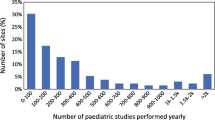Abstract
Background
Estimated radiation dose is important for assessing and communicating the risks and benefits of pediatric nuclear medicine studies. Radiation dose depends on the radiopharmaceutical, the administered activity, and patient factors such as age and size. Most radiation dose estimates for pediatric nuclear medicine have not been based on administered activities of radiopharmaceuticals recommended by established practice guidelines. The dosage card of the European Association of Nuclear Medicine (EANM) and the North American consensus guidelines each provide recommendations of administered activities of radiopharmaceuticals in children, but there are substantial differences between these two guidelines.
Objective
For 12 commonly performed pediatric nuclear medicine studies, two established pediatric radiopharmaceutical administration guidelines were used to calculate updated radiation dose estimates and to compare the radiation exposure resulting from the recommendations of each of the guidelines.
Materials and methods
Estimated radiation doses were calculated for 12 common procedures in pediatric nuclear medicine using administered activities recommended by the dosage card of the EANM (version 1.5.2008) and the 2010 North American consensus guidelines for radiopharmaceutical administered activities in pediatrics. Based on standard models and nominal age-based weights, radiation dose was estimated for typical patients at ages 1, 5, 10 and 15 years and adult. The resulting effective doses were compared, with differences greater than 20% considered significant.
Results
Following either the EANM dosage card or the 2010 North American guidelines, the highest effective doses occur with radiopharmaceuticals labeled with fluorine-18 and iodine-123. In 24% of cases, following the North American consensus guidelines would result in a substantially higher radiation dose. The guidelines of the EANM dosage card would lead to a substantially higher radiation dose in 39% of all cases, and in 62% of cases in which patients were age 5 years or younger.
Conclusion
For 12 commonly performed pediatric nuclear medicine studies, updated radiation dose estimates can guide efforts to reduce radiation exposure and provide current information for discussing radiation exposure and risk with referring physicians, patients and families. There can be substantial differences in radiation exposure for the same procedure, depending upon which of these two guidelines is followed. This discordance identifies opportunities for harmonization of the guidelines, which may lead to further reduction in nuclear medicine radiation doses in children.
Similar content being viewed by others
References
Treves ST, Baker A, Fahey FH et al (2001) Nuclear medicine in the first year of life. J Nucl Med 52:905–925
Committee to assess health risks from exposure to low levels of ionizing radiation (2006) Health risks from exposure to low levels of ionizing radiation: BEIR VII Phase 2. National research council of the national academies. The National Academies Press, Washington
United Nations scientific committee on the effects of atomic radiation (2013) Sources, effects and risks of ionizing radiation. Vol. II, scientific annex B: effects of radiation exposure of children. United Nations Publication E.14.IX.2, New York
ICRP (1971) Protection of the patient in radionuclide investigations. ICRP publication 17. Ann ICRP 17:1–84
Task Group of Committee 2 (1987) Radiation dose to patients from radiopharmaceuticals: ICRP publication 53. Ann ICRP 18:1–377
Valentin J (ed) (1998) Radiation dose to patients from radiopharmaceuticals (addendum 2 to ICRP publication 53): ICRP publication 80. Ann ICRP 28:1–121
ICRP (2008) ICRP publication 106: radiation dose to patients from radiopharmaceuticals: a third amendment to ICRP publication 53. Ann ICRP 38:1–198
Treves ST, Davis RT, Fahey FH (2008) Administered radiopharmaceutical doses in children: a survey of 13 pediatric hospitals in North America. J Nucl Med 49:1024–1027
Lassmann M, Biassoni L, Monsieurs M et al (2007) The new EANM paediatric dosage card. Eur J Nucl Med Mol Imaging 34:796–798
Gelfand MJ, Parisi MT, Treves ST (2011) Pediatric radiopharmaceutical administered doses: 2010 North American consensus guidelines. J Nucl Med 318–322
Treves ST, Parisi MT, Gelfand MJ (2011) Pediatric radiopharmaceutical doses: new guidelines. Radiology 261:347–349
Jacobs F, Thierens H, Piepsz A et al (2005) Optimized tracer-dependent dosage cards to obtain weight-independent effective doses. Eur J Nucl Med Mol Imaging 32:581–588
Cristy M, Eckerman KF (1987) Specific absorbed fractions of energy at various ages from internal photon sources: I. Methods. Oak Ridge National Laboratory, Oak Ridge, TN. ORNL/TM-8381, vol. 1
Stabin MG, Stubbs JB, Toohey RE (1996) Radiation dose estimates for radiopharmaceuticals. Oak Ridge Institute for Science and Education, Oak Ridge, TN. NUREG/CR-6345
Ward VL, Strauss KJ, Barnewolt CE et al (2008) Pediatric radiation exposure and effective dose reduction during voiding cystourethrography. Radiology 249:1002–1009
ICRP (1991) ICRP publication 60: 1990 recommendations of the international committee on radiological protection. Ann ICRP 21:1–201
Valentin J (ed) (2007) The 2007 recommendations of the international commission on radiological protection. ICRP publication 103. Ann ICRP 37:1–332
Seigel JA (2001) Guide for diagnostic nuclear medicine. Society of Nuclear Medicine, Reston, pp 50–51
ICRP (1977) Recommendations of the ICRP. ICRP publication 26. Ann ICRP 1:1–53
Gelfand MJ, Thomas SR, Kereiakes JG (1983) Absorbed radiation dose from routine imaging of the skeleton in children. Ann Radiol 26:421–423
Treves ST, Lassmann M (2014) International guidelines for pediatric radiopharmaceutical administered activities. J Nucl Med 55:869–870
Acknowledgments
This work was presented in part at the International Pediatric Radiology (IPR) 6th Congress and Exhibition of the Joint Societies of Paediatric Radiology, May 2011, London, UK
Conflicts of interest
None
Author information
Authors and Affiliations
Corresponding author
Rights and permissions
About this article
Cite this article
Grant, F.D., Gelfand, M.J., Drubach, L.A. et al. Radiation doses for pediatric nuclear medicine studies: comparing the North American consensus guidelines and the pediatric dosage card of the European Association of Nuclear Medicine. Pediatr Radiol 45, 706–713 (2015). https://doi.org/10.1007/s00247-014-3211-x
Received:
Revised:
Accepted:
Published:
Issue Date:
DOI: https://doi.org/10.1007/s00247-014-3211-x



